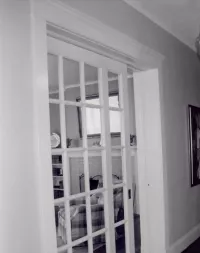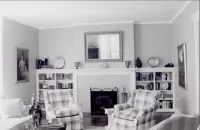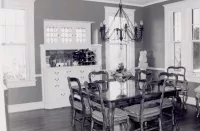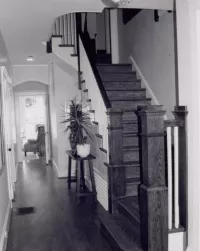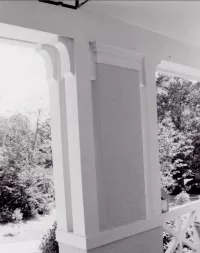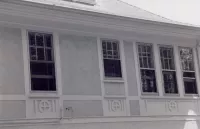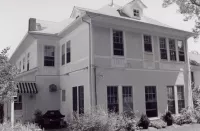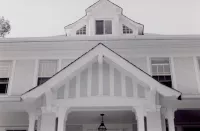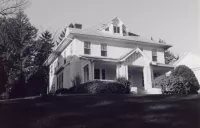Share what you know,
and discover more.
Share what you know,
and discover more.
May 22, 2003
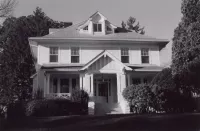
-

- Charmaine Bantugan
National Register of Historic Places - Saegmuller House (DHR File No. 000-0020)
Statement of Significant: The Saegmuller House in Arlington County, likely built sometime between 1925 and 1927, is a rare example of a Prairie-style-influenced residence. One of Arlington's most prominent families, the Saegmullers owned approximately 240 acres of land in this northwestern part of the County. Between 1926 and 1939, the Saegmuller brothers -- John, Frederick, and George -- operated one of Arlington's most successful dairy operations at their Reserve Hill Farm. The Saegmuller House is one of the most stylized early-20th-century dwellings in Arlington County yet still illustrates the practical simplicity of rural architecture. The Saegmuller House meets National Register Criterion C in the area of architecture as a rare and well-preserved example of a Prairie-style-influenced dwelling. It also represents a rare surviving example of high-style domestic architecture in a formerly rural setting. Historical Background The Saegmuller Family The Saegmuller House is located on land originally associated with the Vandenbergh family. Gilbert Vandenbergh purchased 150 acres from his brother John in 1857 and lived there with his wife Sarah (nee Hoes) and their daughters Evaline, Charlotte, and Maria Jane. George Nicholas Saegmuller immigrated to the United States from Germany in 1870 and later married Maria Jane "Ritie" Vandenbergh in 1874. George purchased this 150-acre parcel from his father-in-law, eventually acquiring a total of 243 acres (Saegmuller 1989: 4; 7-8; Burns 1966: 47). George's extensive training in engineering and as a machinist resulted in an impressive technical career. Saegmuller served as chief of the instrument division of the US Coast and Geodetic Survey, as well as designed astronomical and optical instruments for Fauth & Company, which he founded with Camill Fauth and Henry Lockwood in Washington, DC. In the 1880s, Saegmuller modified the use of the telescope in experiments for the Office of the Chief of Naval Ordnance, and eventually secured patents for 39 optical inventions, including a telescopic bore sight (Burns 1966: 47; 49-51). In 1905, the Saegmuller family relocated their business to Rochester, New York, and merged with the Bausch and Lomb Optical Company. George served as a vice president of Bausch and Lomb until retiring and returning to Arlington in 1926 (Saegmuller 1989: 2; Burns 1966: 54). George Saegmuller also was a noted community activist and a prominent figure in the early social and cultural history of Arlington County. In the 1890s, he was elected to the Board of Supervisors of the Washington District and later served as Chairman of the Board. Saegmuller advanced personal funds to improve roads, build the Saegmuller School for children in north Arlington, and even rescued the finances and restored the credit of Alexandria (now Arlington) County. Perhaps most significantly, Saegmuller advocated the construction of Alexandria County's first courthouse and jail in 1898 (Burns 1966: 52-3). George Saegmuller constructed a prominent stone manor house known as Reserve Hill. Named for the reserve Federal troops stationed in the area during the Civil War, the mansion replaced an earlier 2-story frame farmhouse on the site. Reserve Hill still stands to the west of the Saegmuller House and is now owned by the Knights of Columbus. By the time Reserve Hill was completed about 1905, the Saegmullers moved to Rochester, New York, and planned to use their new Arlington residence as a vacation home. Reserve Hill boasted the newest technological advancements of its time, including running water, four bathrooms (one equipped with a shower), and a lighting system powered by acetylene gas. The home also featured a massive water tower modeled after a tower in Nürnberg (Burns 1966: 51; Saegmuller 1989: 9-10; 21). At Reserve Hill, the Saegmullers raised cows, horses, pigs, chickens, geese, and guinea hens, grew corn and hay, and maintained a vineyard and orchard. In addition to the mansion, the property included three tenant farmers' homes and another house for the foreman (Saegmuller 1989: 11-12). By 1890, George N. Saegmuller was considered one of the "principal farmers" of the Walker Chapel area of Alexandria County (present-day northern Arlington County) (Chataigne 1890: 152). In a deed dated July 28, 1913, George and Maria Saegmuller formally established their family farm in the County of Alexandria (Arlington). Comprised of ten separate parcels acquired between 1877 and 1905, it was the Saegmullers' intention "to unite all the lands...into one parcel or tract of land to be known as the 'Saegmuller Farm" (Arlington County Deed Book 128: 580). The entire parcel, which amounted to 240.71 acres as surveyed by George E. Garrett in April 1911, later was conveyed to the three Saegmuller sons on April 26, 1932 (Arlington County Deed Books 128: 581 and 333: 11). John Leonard (Lee) Saegmuller was born June 18, 1875 at Reserve Hill (Anonymous, 12/21/61), the eldest son of George Nicholas and Maria Jane Saegmuller. He had two younger brothers, Frederick B. and George Marshall Saegmuller, as well as a sister, Babette, who died as a teenager (Burns 1966: 51). John Saegmuller attended public schools in both Virginia and Washington, DC, and also spent five years in Germany studying how to make engineering tools. Upon returning from Europe, John worked at his father's Washington, DC, factory, Fauth & Company (Anonymous, 12/21/61; Burns 1966: 50). In 1905, the Saegmuller family relocated their business to Rochester, New York, merging with the Bausch and Lomb Optical Company. In 1917, John returned to Arlington to serve as the head of Bausch and Lomb's Washington, DC, office in the Albee Building on 15th Street, NW. John held this position until his retirement in 1926. Until 1939, John and his brothers operated Reserve Hill as a dairy farm. John also served as a trustee of the Rock Spring Congregational Church, was a member of the National Association of Watch and Clock Collectors, and participated in the Arlington Historical Society (Anonymous, 12/21/61; Suter 1991: 12). John Leonard Saegmuller died December 20, 1961, survived by his wife Virginia Fitzhugh Saegmuller and two children, George Nicholas and Louisa (Arlington County Will Book 44: 438-39). He is buried at Columbia Gardens Cemetery in central Arlington. At the time of his death, his permanent residence was 3021 North Edison Street (Anonymous, 12/21/61).
National Register of Historic Places - Saegmuller House (DHR File No. 000-0020)
Statement of Significant: The Saegmuller House in Arlington County, likely built sometime between 1925 and 1927, is a rare example of a Prairie-style-influenced residence. One of Arlington's most prominent families, the Saegmullers owned approximately 240 acres of land in this northwestern part of the County. Between 1926 and 1939, the Saegmuller brothers -- John, Frederick, and George -- operated one of Arlington's most successful dairy operations at their Reserve Hill Farm. The Saegmuller House is one of the most stylized early-20th-century dwellings in Arlington County yet still illustrates the practical simplicity of rural architecture. The Saegmuller House meets National Register Criterion C in the area of architecture as a rare and well-preserved example of a Prairie-style-influenced dwelling. It also represents a rare surviving example of high-style domestic architecture in a formerly rural setting. Historical Background The Saegmuller Family The Saegmuller House is located on land originally associated with the Vandenbergh family. Gilbert Vandenbergh purchased 150 acres from his brother John in 1857 and lived there with his wife Sarah (nee Hoes) and their daughters Evaline, Charlotte, and Maria Jane. George Nicholas Saegmuller immigrated to the United States from Germany in 1870 and later married Maria Jane "Ritie" Vandenbergh in 1874. George purchased this 150-acre parcel from his father-in-law, eventually acquiring a total of 243 acres (Saegmuller 1989: 4; 7-8; Burns 1966: 47). George's extensive training in engineering and as a machinist resulted in an impressive technical career. Saegmuller served as chief of the instrument division of the US Coast and Geodetic Survey, as well as designed astronomical and optical instruments for Fauth & Company, which he founded with Camill Fauth and Henry Lockwood in Washington, DC. In the 1880s, Saegmuller modified the use of the telescope in experiments for the Office of the Chief of Naval Ordnance, and eventually secured patents for 39 optical inventions, including a telescopic bore sight (Burns 1966: 47; 49-51). In 1905, the Saegmuller family relocated their business to Rochester, New York, and merged with the Bausch and Lomb Optical Company. George served as a vice president of Bausch and Lomb until retiring and returning to Arlington in 1926 (Saegmuller 1989: 2; Burns 1966: 54). George Saegmuller also was a noted community activist and a prominent figure in the early social and cultural history of Arlington County. In the 1890s, he was elected to the Board of Supervisors of the Washington District and later served as Chairman of the Board. Saegmuller advanced personal funds to improve roads, build the Saegmuller School for children in north Arlington, and even rescued the finances and restored the credit of Alexandria (now Arlington) County. Perhaps most significantly, Saegmuller advocated the construction of Alexandria County's first courthouse and jail in 1898 (Burns 1966: 52-3). George Saegmuller constructed a prominent stone manor house known as Reserve Hill. Named for the reserve Federal troops stationed in the area during the Civil War, the mansion replaced an earlier 2-story frame farmhouse on the site. Reserve Hill still stands to the west of the Saegmuller House and is now owned by the Knights of Columbus. By the time Reserve Hill was completed about 1905, the Saegmullers moved to Rochester, New York, and planned to use their new Arlington residence as a vacation home. Reserve Hill boasted the newest technological advancements of its time, including running water, four bathrooms (one equipped with a shower), and a lighting system powered by acetylene gas. The home also featured a massive water tower modeled after a tower in Nürnberg (Burns 1966: 51; Saegmuller 1989: 9-10; 21). At Reserve Hill, the Saegmullers raised cows, horses, pigs, chickens, geese, and guinea hens, grew corn and hay, and maintained a vineyard and orchard. In addition to the mansion, the property included three tenant farmers' homes and another house for the foreman (Saegmuller 1989: 11-12). By 1890, George N. Saegmuller was considered one of the "principal farmers" of the Walker Chapel area of Alexandria County (present-day northern Arlington County) (Chataigne 1890: 152). In a deed dated July 28, 1913, George and Maria Saegmuller formally established their family farm in the County of Alexandria (Arlington). Comprised of ten separate parcels acquired between 1877 and 1905, it was the Saegmullers' intention "to unite all the lands...into one parcel or tract of land to be known as the 'Saegmuller Farm" (Arlington County Deed Book 128: 580). The entire parcel, which amounted to 240.71 acres as surveyed by George E. Garrett in April 1911, later was conveyed to the three Saegmuller sons on April 26, 1932 (Arlington County Deed Books 128: 581 and 333: 11). John Leonard (Lee) Saegmuller was born June 18, 1875 at Reserve Hill (Anonymous, 12/21/61), the eldest son of George Nicholas and Maria Jane Saegmuller. He had two younger brothers, Frederick B. and George Marshall Saegmuller, as well as a sister, Babette, who died as a teenager (Burns 1966: 51). John Saegmuller attended public schools in both Virginia and Washington, DC, and also spent five years in Germany studying how to make engineering tools. Upon returning from Europe, John worked at his father's Washington, DC, factory, Fauth & Company (Anonymous, 12/21/61; Burns 1966: 50). In 1905, the Saegmuller family relocated their business to Rochester, New York, merging with the Bausch and Lomb Optical Company. In 1917, John returned to Arlington to serve as the head of Bausch and Lomb's Washington, DC, office in the Albee Building on 15th Street, NW. John held this position until his retirement in 1926. Until 1939, John and his brothers operated Reserve Hill as a dairy farm. John also served as a trustee of the Rock Spring Congregational Church, was a member of the National Association of Watch and Clock Collectors, and participated in the Arlington Historical Society (Anonymous, 12/21/61; Suter 1991: 12). John Leonard Saegmuller died December 20, 1961, survived by his wife Virginia Fitzhugh Saegmuller and two children, George Nicholas and Louisa (Arlington County Will Book 44: 438-39). He is buried at Columbia Gardens Cemetery in central Arlington. At the time of his death, his permanent residence was 3021 North Edison Street (Anonymous, 12/21/61).
May 22, 2003
National Register of Historic Places - Saegmuller House (DHR File No. 000-0020)
Statement of Significant:The Saegmuller House in Arlington County, likely built sometime between 1925 and 1927, is a rare example of a Prairie-style-influenced residence. One of Arlington's most prominent families, the Saegmullers owned approximately 240 acres of land in this northwestern part of the County. Between 1926 and 1939, the Saegmuller brothers -- John, Frederick, and George -- operated one of Arlington's most successful dairy operations at their Reserve Hill Farm. The Saegmuller House is one of the most stylized early-20th-century dwellings in Arlington County yet still illustrates the practical simplicity of rural architecture. The Saegmuller House meets National Register Criterion C in the area of architecture as a rare and well-preserved example of a Prairie-style-influenced dwelling. It also represents a rare surviving example of high-style domestic architecture in a formerly rural setting.
Historical Background
The Saegmuller Family
The Saegmuller House is located on land originally associated with the Vandenbergh family. Gilbert Vandenbergh purchased 150 acres from his brother John in 1857 and lived there with his wife Sarah (nee Hoes) and their daughters Evaline, Charlotte, and Maria Jane. George Nicholas Saegmuller immigrated to the United States from Germany in 1870 and later married Maria Jane "Ritie" Vandenbergh in 1874. George purchased this 150-acre parcel from his father-in-law, eventually acquiring a total of 243 acres (Saegmuller 1989: 4; 7-8; Burns 1966: 47).
George's extensive training in engineering and as a machinist resulted in an impressive technical career. Saegmuller served as chief of the instrument division of the US Coast and Geodetic Survey, as well as designed astronomical and optical instruments for Fauth & Company, which he founded with Camill Fauth and Henry Lockwood in Washington, DC. In the 1880s, Saegmuller modified the use of the telescope in experiments for the Office of the Chief of Naval Ordnance, and eventually secured patents for 39 optical inventions, including a telescopic bore sight (Burns 1966: 47; 49-51). In 1905, the Saegmuller family relocated their business to Rochester, New York, and merged with the Bausch and Lomb Optical Company. George served as a vice president of Bausch and Lomb until retiring and returning to Arlington in 1926 (Saegmuller 1989: 2; Burns 1966: 54).
George Saegmuller also was a noted community activist and a prominent figure in the early social and cultural history of Arlington County. In the 1890s, he was elected to the Board of Supervisors of the Washington District and later served as Chairman of the Board. Saegmuller advanced personal funds to improve roads, build the Saegmuller School for children in north Arlington, and even rescued the finances and restored the credit of Alexandria (now Arlington) County. Perhaps most significantly, Saegmuller advocated the construction of Alexandria County's first courthouse and jail in 1898 (Burns 1966: 52-3).
George Saegmuller constructed a prominent stone manor house known as Reserve Hill. Named for the reserve Federal troops stationed in the area during the Civil War, the mansion replaced an earlier 2-story frame farmhouse on the site. Reserve Hill still stands to the west of the Saegmuller House and is now owned by the Knights of Columbus. By the time Reserve Hill was completed about 1905, the Saegmullers moved to Rochester, New York, and planned to use their new Arlington residence as a vacation home. Reserve Hill boasted the newest technological advancements of its time, including running water, four bathrooms (one equipped with a shower), and a lighting system powered by acetylene gas. The home also featured a massive water tower modeled after a tower in Nürnberg (Burns 1966: 51; Saegmuller 1989: 9-10; 21).
At Reserve Hill, the Saegmullers raised cows, horses, pigs, chickens, geese, and guinea hens, grew corn and hay, and maintained a vineyard and orchard. In addition to the mansion, the property included three tenant farmers' homes and another house for the foreman (Saegmuller 1989: 11-12). By 1890, George N. Saegmuller was considered one of the "principal farmers" of the Walker Chapel area of Alexandria County (present-day northern Arlington County) (Chataigne 1890: 152). In a deed dated July 28, 1913, George and Maria Saegmuller formally established their family farm in the County of Alexandria (Arlington). Comprised of ten separate parcels acquired between 1877 and 1905, it was the Saegmullers' intention "to unite all the lands...into one parcel or tract of land to be known as the 'Saegmuller Farm" (Arlington County Deed Book 128: 580). The entire parcel, which amounted to 240.71 acres as surveyed by George E. Garrett in April 1911, later was conveyed to the three Saegmuller sons on April 26, 1932 (Arlington County Deed Books 128: 581 and 333: 11).
John Leonard (Lee) Saegmuller was born June 18, 1875 at Reserve Hill (Anonymous, 12/21/61), the eldest son of George Nicholas and Maria Jane Saegmuller. He had two younger brothers,
Frederick B. and George Marshall Saegmuller, as well as a sister, Babette, who died as a teenager (Burns 1966: 51). John Saegmuller attended public schools in both Virginia and Washington, DC, and also spent five years in Germany studying how to make engineering tools. Upon returning from Europe, John worked at his father's Washington, DC, factory, Fauth & Company (Anonymous, 12/21/61; Burns 1966: 50). In 1905, the Saegmuller family relocated their business to Rochester, New York, merging with the Bausch and Lomb Optical Company. In 1917, John returned to Arlington to serve as the head of Bausch and Lomb's Washington, DC, office in the Albee Building on 15th Street, NW. John held this position until his retirement in 1926. Until 1939, John and his brothers operated Reserve Hill as a dairy farm. John also served as a trustee of the Rock Spring Congregational Church, was a member of the National Association of Watch and Clock Collectors, and participated in the Arlington Historical Society (Anonymous, 12/21/61; Suter 1991: 12). John Leonard Saegmuller died December 20, 1961, survived by his wife Virginia Fitzhugh Saegmuller and two children, George Nicholas and Louisa (Arlington County Will Book 44: 438-39). He is buried at Columbia Gardens Cemetery in central Arlington. At the time of his death, his permanent residence was 3021 North Edison Street (Anonymous, 12/21/61).
Posted Date
Jul 11, 2023
Historical Record Date
May 22, 2003
Source Name
National Register of Historic Places
Source Website
Delete Story
Are you sure you want to delete this story?


